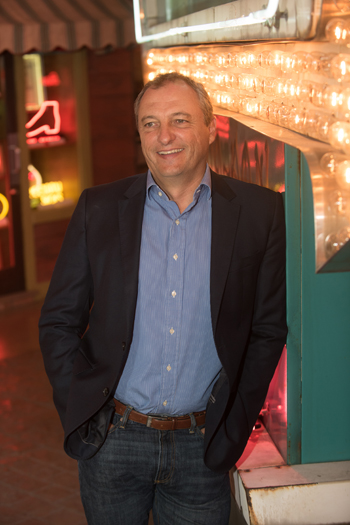Education
Food for Thought
Published
7 years agoon
By
BXP StaffALEX TOSOLINI, SENIOR vice president of new business development at Kroger and former senior vice-president of global e-business at Procter & Gamble, will be a speaker at the new international brand conference and festival Brandemonium, to be held at the Duke Energy Convention Center in Cincinnati on October 11 to 14. As part of our partnership with Brandemonium, Brand Experience magazine interviewed Tosolini, at the American Sign Museum also located in Cincinnati, to get a glimpse into Tosolini’s insights on essentials to brand survival, what every marketer needs to succeed in new environments and the role data plays when developing and executing marketing strategies.
Stakes for Survival
 “I don’t think any company or brand can survive without having great data, and more importantly the ability or the capability to do something good with the data,” says Tosolini. “Think about the hundreds of decisions a company needs to make, and data is linked to every decision. Whether you’re in marketing or manufacturing, in logistics or product supply, wherever you are, the common denominator, in my opinion, is having great data and being able to analyze it, to help you make decisions.”
“I don’t think any company or brand can survive without having great data, and more importantly the ability or the capability to do something good with the data,” says Tosolini. “Think about the hundreds of decisions a company needs to make, and data is linked to every decision. Whether you’re in marketing or manufacturing, in logistics or product supply, wherever you are, the common denominator, in my opinion, is having great data and being able to analyze it, to help you make decisions.”
Data is so important to the company Tosolini currently serves, that it made a significant financial investment in data services. “Every company has a different approach, and my personal experience relates to two big companies—both of which are extremely focused and obsessed with using data to its fullest. If I can talk about my current experience, Kroger partnered with a company called 84.51°, that is now part of the Kroger family, and they’re amongst the best in the world in taking data and turning it into some amazing insights and workable plans. Every decision that we make at Kroger, is somehow linked to the data. So, whether it’s discovering the right assortment for a specific store in a certain location, creating profiles to understand a certain consumer group, determining where to open a store and how to design that store, every single decision is somehow related to smart use of data. So every brand you see there, every assortment, every promotion, every activity is the result of good data analytics, and smart recommendations based on the data analysis.”
Data, Tosolini continues, can also help create a climate where open, unbiased discussions can take place.
Failure as a Learning Platform
“You always want to build on the learnings from the past, to do a much better job in the future,” Tosolini explains. “The idea is to create a culture, where failure is accepted as a means to an end. When you create permission to fail, it becomes easier to everyone to learn from mistakes so the entire organization becomes better. I don’t want to come across as thinking this is something easy, but it is important because you want to use failure as a learning platform to move faster and better for the next project.”
He explains that by sharing information about our failures not only across our teams but also across departments, business leaders can leverage the learnings in a profound way, noting how the best companies leverage information about successes and failures across their organizations. During our interview, we also discussed how Amazon leveraged information from its mobile phone project to further the development of the Echo ecosystem. “There’s no way you can move fast these days without skills like collaboration and working well with each other,” Tosolini adds. “And what I mean by that is not just we get along with each other, it’s really about having an open discussion where we exchange our data driven analysis and our own intuitive assessments for a result that is much more profound, than if either you or I, look at the problem alone.
Advertisement“Obviously, if a company only makes mistakes and they only deliver failures, that’s not sustainable,” he explains, “but you also don’t want to create a fear factor where people, rather than taking a risk because they are afraid of failing, they don’t move.”
Value the Drivers of Past Successes
As much as there’s need for forward momentum, Tosolini warns about getting so obsessed with the new that you leave behind drivers of past successes. Tosolini has lived and worked in several countries throughout Europe and now is based here in the U.S. From these experiences, he’s taken away some tips for marketers when working in new environments.
“First thing that I do is try to understand the past,” he explains. “You always want to understand the past because there’s always a lot of things from the past that you want to keep. You want to be able to repeat behaviors that you know are still relevant and valued for the future.
“Also, this is for marketing, but frankly, any team I’ve had experience with, you also want to make sure the team understands where they are going,” Tosolini continues. “Whether you call this purpose or vision, you must make sure—everyone is clear on what you are trying to achieve. You also want to give people work that they feel is meaningful.”
Put in the Time
The most meaningful part of marketers’ jobs is delivering for the customer. “One way to look at this, first and foremost, is consumer understanding,” Tosolini says. “The best marketing people need to spend a crazy amount of time understanding their consumers or customers.
“One thing we are learning about  the shopping world is that historically most people were focused on what we call ‘functional needs’ such as ‘save me money’ and ‘saves me time,’” he explains. “Now to be clear, those functional needs are still very important. But what we are seeing is the emergence of three emotional needs which consumers are telling us they are looking for in their shopping and brand relationships. The first emotional need is, ‘I want to feel connected to my community, but also to the brands I have a relationship with.’ They also tell us, ‘I want to feel inspired.’ Finally, they tell us, ‘I want to be cared for.’”
the shopping world is that historically most people were focused on what we call ‘functional needs’ such as ‘save me money’ and ‘saves me time,’” he explains. “Now to be clear, those functional needs are still very important. But what we are seeing is the emergence of three emotional needs which consumers are telling us they are looking for in their shopping and brand relationships. The first emotional need is, ‘I want to feel connected to my community, but also to the brands I have a relationship with.’ They also tell us, ‘I want to feel inspired.’ Finally, they tell us, ‘I want to be cared for.’”
One of Tosolini’s favorite brands addresses both sets of needs well. “For the people that know me very well, they know I’ve got a passion for Nutella, which is a chocolate spread,” Tosolini shares. “Nutella is a big emotional brand for me because it connects at multiple levels. Nutella does two things, which are pretty amazing: They keep the quality of the products high, and they also go to market with story telling that goes beyond the taste of chocolate.”
Thriving in a Digital World
“Marketers can meet these two functional needs and the three emotional needs in an amplified way because of new digital capabilities and the digital world we live in,” Tosolini says. “Through digital and physical experiences, you can really fulfill consumer needs in a more complete way. Brands are able to read consumer sentiments, positive or negative, in real time, and that has never happened before.”
Additionally, digital technologies are enabling brands to connect better and more often to their customers. “If I go back down memory lane, one of the best examples where we were able to leverage digital is the 2008 Tide to Go Talking Stain Super Bowl commercial,” he shares. “The P&G brand managers decided to ask consumers to film spoofs of the Talking Stain commercial. We received somewhere between 40 to 50 commercials sent to us by consumers, doing their own version of the TV commercial. It created a two-way communication with consumers. We knew that engaging the consumers into the discussion was the best way to build the brand, and this was back almost 10 years ago.”
Thanks to technology, brands have a variety of ways to connect with consumers and, as Tosolini says, consumers have more power today than ever before to influence brands. But he calls on the industry to remember to use those connections wisely. “Brands play such a huge role in our society, and the power of positive brands can really change the lives of the people for the better,” Tosolini urges. “Turn brands into forces of good.”

BXP elevates the value of innovative and collaborative brand package design as a strategic business competence across the omni-channel path to purchase, to ultimately help consumer facing and retail brands deliver more relevant experiences that connect with shoppers, win at shelf, own the moment of sale and maximize brand loyalty.
SPONSORED VIDEO
Branding with Ferocity – Thinking Like an Indie Brand
Get a better understanding on how to leverage new technologies to engage and delight shoppers, sustainability’s role in product and package design – being sustainable and premium are not mutually exclusive, plus best practices and tips for collaboration and how to launch new products and refresh existing product line-ups and brands.
You may like
Advertisement

GO MINIMALISM . . . HOLD ON A MINUTE!
Sustainable, 100% Recycled Transparent Sheeting is Now a Reality!

Kroger, Walgreens to Dedicate Section of Their Stores to Reusable Packaging

6 Marketing Tips for Ecommerce Brands to Win the Holiday Shopping Season

New Wunderoots Branding Celebrates the Carrot

Fact or Fiction? The Truth about Eco-Friendly Packaging

BXP May 2021 Think & Clink

Unilever Raises Bar for Accessibility with Degree Inclusive

Crown Royal’s Limited-Edition Pack Designed by Oscar-Winner

Coca-Cola Explores World of Paper Bottles
Subscribe

BULLETINS
Get the most important news and business
ideas from BXP Magazine's news bulletin.
Latest Tweets
Advertisement


